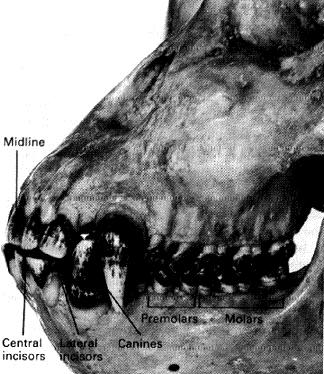The jaws of primates are made of two bones: the maxilla and the mandible. Each bone contains a specific number and type of teeth.

The jaws of primates are made
of two bones: the maxilla and the mandible. Each bone contains a specific
number and type of teeth. 
Primates have four kinds of teeth
in their mouths: incisors, canines, premolars, and molars. Incisors are
located in the front of the mouth, and are used for nipping off pieces
of food. Canine teeth are sharp and pointed. They are sometimes referred
to as "eye-teeth". The primary function of canines is to puncture and rip
off. Premolars are low wide teeth that are located behind the canines.
Molars are the largest teeth found in the mouth and are located behind
the premolars. Both molars and premolars are used for crushing and grinding
food.
The number of teeth is different in different primates. Being able to count the different types of teeth can help you classify a primate.
The number and type of teeth found in the mouth of an animal are known as the dental formula. The dental formula is used to identify and classify primates. To determine the number of teeth in the mouth:
What is the dental formula for this primate? How many total teeth does this primate jaw contain?
(need a picture)